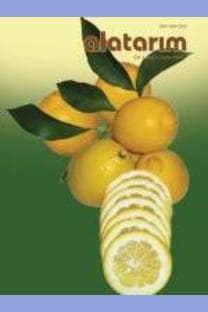Çukurova Bölgesinde ergin çekirdeksiz sofralık üzüm çeşidinde bitki su stresinin infrared Termometre ile izlenmesi
Evaluation of crop water stress with infrared thermometer in ergin çekirdeksiz table grape variety in the mediterranean region
___
- Gachons, C.P., Leeuwen, C.V., Tominaga, T., Soyer, J.P., Gaudillere, J.P. and Dubourdieu, D., 2005. Influence of Water and Nitrogen Deficit on Fruit Ripening and Aroma Potential of Vitis Vinifera L. Cv. Sauvignon Blanc in Field Conditions. J. of the Sci. of Food Agric., 85(1): 73-85.
- Garrot, D.J., Gibson, R, D., Kilby, M.W., 1998. The Response of Table Grape Growth, Production and Ripening to Water Stress. Publication AZ1051: College of Agriculture, The University of Arizona, Tucson, AZ, USA.
- Grimes, D.W., Williams L.E., 1990. Irrigation Effects on Plant Water Relations and Productivity of Thompson Seedless Grapevines. Crop Science, 30:255-260,
- Howell, T.A., Yazar, A., Schneider, A.D., Dusek, D.A and Copeland, K.S., 1995. Yield and Water Use Efficiency of Corn in Response to LEPA Irrigation. ASAE Trans. of the ASAE, 38(6):1737-1747.
- Idso, S.B., Jackson, R.D., Pinter, JR., P.J., Reginato, R.J., Hatfield, J.L., 1981. Normalizing the Stress Degree Day Parameter for Environmental Variability. Agricultural Meteorology, 24: 45-55.
- Jackson, R.D., 1982. Canopy Temperature and Crop Water Stress. Advances in Irrigation. Edited by Daniel Hillel. Academic Press, New York. London, 1:43-85.
- O’toole, J.C., Real, J.G., 1986. Estimation of Aerodynamic and Crop Resistances From Canopy Temperature. Agron. J. 78:305-310.
- Smart, R.E., Coombe, B.G., 1983. Water Relations of Grapevines. (T.T. Kozlowski editor). Water Deficits and Plant Growth, Chapter 4, Academic Press, New York-London, 137- 196.
- Uzun, İ., Bayır, A., 2008. Türkiye’de Bağcılık Bülten UASVM, Bahçe Bitkileri, 65(1):334-337.
- Williams, L.E., Matthews, M.A., 1990. Grapevine. (B.A. Stewart and D.R. Nielson editors), Irrigation of Agricultural Crops. American Crops. Am. Soc. Agron., 30: 1019-1055.
- Van Zyl, J.L., 1986. Canopy Temperature as a Water Stress Indicator in Vines. S. Afr. J. Enol. Vitic. 7:53-60.
- Zabihi, H.R., 2006. Grape Responses to Different Soil Moisture Regimes, Acta Hort., 652: 233- 237.
- Zipoli, G., 1990. Remote Sensing for Scheduling Irrigation: Review of Thermal Infrared Approach. Acta Horticulture Vol:1(1-442): 281-288.
- ISSN: 1304-2653
- Yayın Aralığı: 2
- Başlangıç: 2015
- Yayıncı: Alata Bahçe Kültürleri Araştırma Enstitüsü
Güçer KAFA, TURGUT YEŞİLOĞLU, AYHAN AYDIN, ONUR UYSAL
Yeşim ÇOLAK BOZKURT, Attila YAZAR, S. Metin SEZEN, SEMİH TANGOLAR
Turunçgillerde en uygun satış zamanının belirlenmesi
OSMAN UYSAL, O.Sedat SUBAŞI, MUSTAFA ÜNLÜ
Mersin ili turunçgil ihracatı yapan paketleme tesislerinin yaşadıkları sorunlar ve çözüm önerileri
O.Sedat SUBAŞI, OSMAN UYSAL, MUSTAFA ÜNLÜ
Manaz Meyvesi (Amelanchier alnifolia Nutt. ex M. Roem)
MUHARREM ERGUN, Abdullah OSMANOĞLU, NUSRET ÖZBAY, Atilla Çakır
